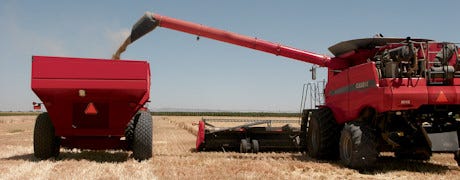
As we reported in our January 2013 cover story, "The new age of smart iron," telematics is a game-changer in agriculture technology. This technology allows machines to, in effect, talk to or control each other on-the-go. But how will this gee-whiz tech help your pocketbook?
"It's too early to pretend that we know the economics of telematics," says Terry Kastens, professor emeritus of ag economics at Kansas State. He says telemetry is the technology that allows data measurements at a distance, typically wirelessly, while telematics might best be described as the application of telemetry.

AT WORK: Rising interest in telematics and automation may have a place on the farm.
Smart-phone based car insurance is an example of telematics, Kastens says. "You use your cell phone to interact with the insurance company and gather driving data. If the data shows you to be a good driver, you get lower rates."
Another example is the fleet management of trucks where automatic driver logs collect data about where the truck is located, when it is sitting still, when it is moving, etc. And a fleet manager at a computer can make decision about load dispatching and what driver to send where.
Agricultural use of telematics entails using an office-based coordinator to dispatch support vehicles, monitor machine performance, troubleshoot problems and train employees.
But the future of the technology lies in two machines in the same field knowing headland and application coverage, no matter which machine covered it first. Or a grain cart operator knowing the location and fullness of each combine bin and where it will be in the field when it gets full, or combine operators knowing the status of grain carts and trucks and being able to route them between and within fields.

Terry Kastens, professor emeritus of ag economics at K-State
Finally, of course, there are robotic machines that talk to each other.
Now or later
What kind of technology is used depends on whether a decision needs to be made now, in real time, or whether it can be analyzed later, Kastens says. One problem holding back the real-time data handling is that cell phones and radios are not always dependable while hard drives and flash drives are usually trouble-free.
It might be that the best use of technology is simply to collect the data and then study it to pinpoint operational inefficiencies such as long waits for getting grain carts or tendering vehicles in place, machine overlap, time spent on the road and terrain-based delays.
"It gives you hard data for your GPS guidance software, so you can verify assumptions," Kastens says.
Getting to the future is going to require reliable wireless communication, new sensors on machines to collect the data you need, new and easy to understand in-cab displays and collecting the right data.
"Frequently, the time you spend driving down the road and between fields is underestimated," Kastens says. "So is the time to drive a tender vehicle to the sprayer to recharge the tank."
Average travel speeds are less than the driver thinks and he spends more time thinking or pushing buttons on the display than he realizes. Finally overlap is more than often realized because slowing down in the headland puts on extra coverage.
A lot of people will get involved with the "cool, real-time stuff" that manufacturers will offer, but only a few will analyze the data it collects and change the way they manage their operation to respond, Kastens says.
"That is the way to gain an edge over other producers," he concludes.
- Griekspoor is editor of sister publication Kansas Farmer
About the Author(s)
You May Also Like




